This year, Singapore commemorates the 80th anniversary of the Fall of Singapore and the Japanese Occupation. Over the course of this week, Mothership will be republishing stories that highlight the key events that marked one of the darkest chapters in Singapore's history.
It was 1941. Japan had already been in a long-drawn-out war with China.
The raw materials that Japan needed for the war, particularly oil, were in short supply — thanks to trade embargoes by the U.S., UK and the Netherlands.
Desperate for raw materials such as tin and rubber, Japan decided to snatch them from Allied territories in Southeast Asia — the Malay Peninsula and the Dutch Indies.
The stories below are meant to give you a better picture of the mounting tension as the Imperial Japanese Army swept its way through Malaya to Singapore. They feature fictitious characters but the events described are based on actual events that occurred during the war.
Upper Cross Street, Singapore December 8, 1941, 4:30am
Nadia Hassan woke up in her home startled by the deafening explosion that pierced the darkness. Unknown to her, it was an air raid by Japanese forces — the first of many to scar the island in the coming weeks.
Another explosion rattled the walls, and Nadia's baby started wailing from his crib. She hurried over and held him close as she gazed out in horror at the burning bodies littered outside her window.
She wasn't surprised that war had arrived. After all, it was all that people could talk about on the streets over the past weeks. However, all that talk did not prepare her for this nightmare.
Raffles Place, Tengah Air Base, Seletar Air Base, and Keppel Harbour went up in flames as the air raid sirens failed to sound an advance warning. Within a night, the British lost nearly all of its frontline aeroplanes in Singapore.
Across the world, the same destruction was witnessed at Pearl Harbour, Hong Kong, and the Philippines — an opening act to the vengeance that Japan sought to inflict upon the Allied forces for their interference in the Sino-Japanese War.
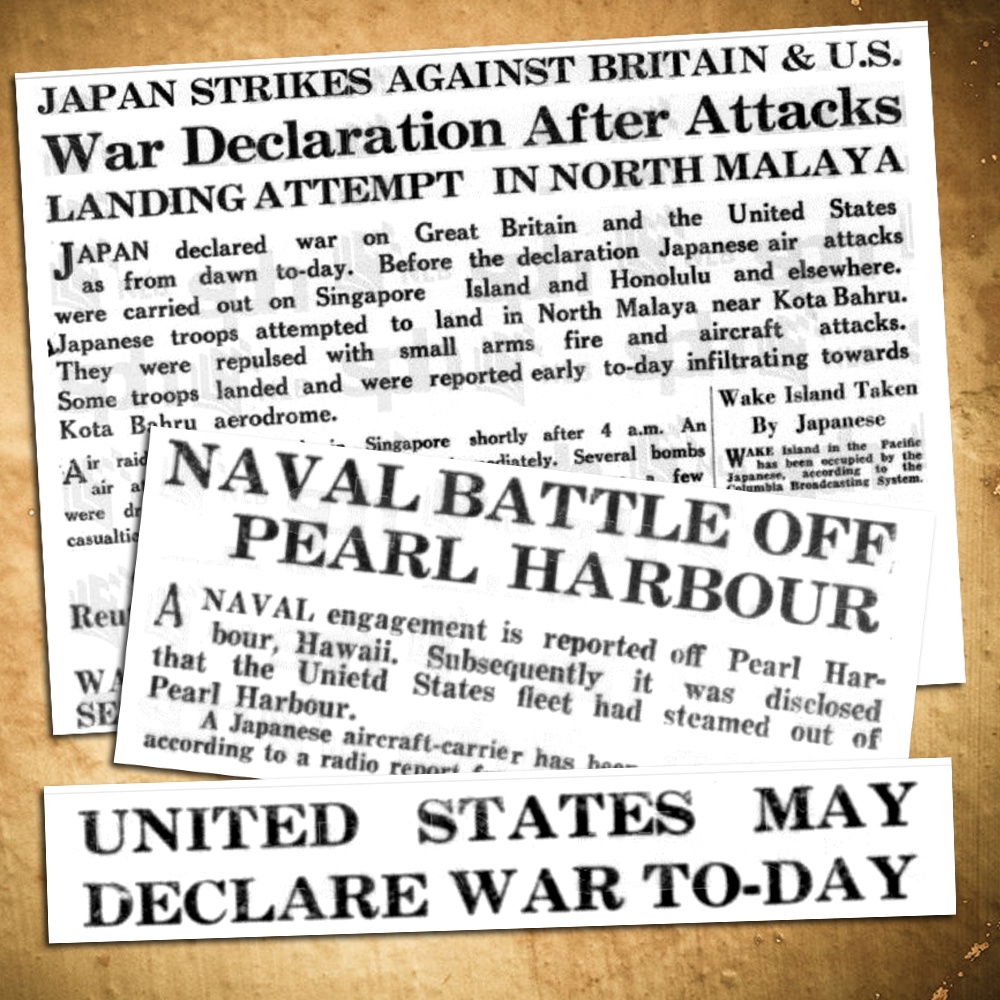 Articles from The Straits Times dated December 8, 1941. Taken from NewspaperSG.
Articles from The Straits Times dated December 8, 1941. Taken from NewspaperSG.
As the bombs rained down on Singapore, the Imperial Japanese Army started its invasion of northern Malaya.
It was the start of the Malayan Campaign, the trail of battles fought along the Malay Peninsula from December 8, 1941 to January 31, 1942 as the the Imperial Army razed southwards, making its way to Britain's crown jewel, the impenetrable "Gibraltar of the East" — Singapore.
55 days. That's how long it would take the Japanese troops to decimate Malaya before arriving at Singapore's doorstep.
 The deployment of Allied Forces during the Malayan Campaign. Image from Surviving the Japanese Occupation: War and its Legacies.
The deployment of Allied Forces during the Malayan Campaign. Image from Surviving the Japanese Occupation: War and its Legacies.
South China Sea, off Kuantan, Pahang
December 10, 1941, 12:30pm
The Japanese managed to inflict the greatest British naval defeat by sinking two warships — HMS Prince of Wales and HMS Repulse — all within a span of 90 minutes.
Each warship was hit by four Japanese torpedoes. In comparison, the British only managed to down four Japanese aircraft.
It was becoming increasingly clear to the Allied forces that they were being outwitted and outgunned by the Japanese on land, sea, and air.
They were fighting a losing battle.
Singapore Causeway January 31, 1942, 8:15am
Each time Private Jerry Gladwell of the 53rd Infantry Brigade closed his eyes, he would picture the massacre that occurred a week earlier in the town of Parit Sulong.
It made him sick to survey the aftermath of the bloodbath: Tied-up flesh burnt beyond recognition, piles of bodies gunned down on the roads, and mowed over by heavy trucks. One body was riddled with so many bullets, it was practically see-through.
There were rumours that soldiers from the Imperial Army had doused captive Australian soldiers in petrol and set them on fire on a whim. Gladwell's stomach churned at the thought.
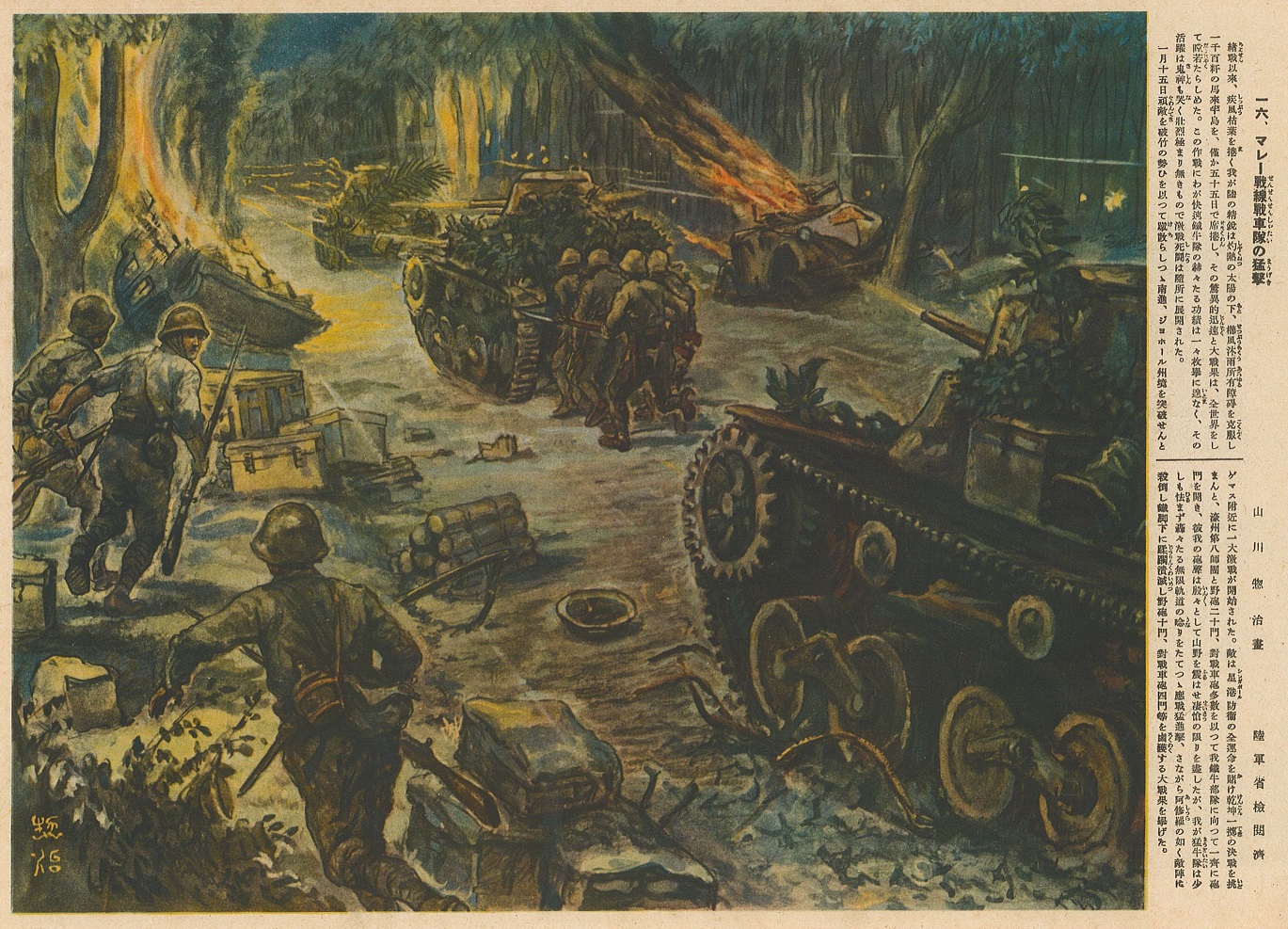 Artist impression of Japanese troops advancing Parit Sulong, Malaya in 1942. Image via the Australian War Memorial.
Artist impression of Japanese troops advancing Parit Sulong, Malaya in 1942. Image via the Australian War Memorial.
This wasn't the war he wanted to be involved in.
He wanted to be back in Europe fighting against the Nazis. That was where the real fight was, he thought.
Instead, he was flown halfway across the world to trek through the humid jungles of Malaya. God forbid he should die in the jungle without actually bayonetting a Nazi in his life.
Gladwell was quite certain that he wouldn't make it out of this fight alive. The Japanese troops had out-manoeuvred the Allied forces throughout the Peninsula and forced them southward. The latter had no choice but to retreat to Singapore and blow up the Causeway in a last-ditch effort to stall the Imperial Army.
Malaya was lost and the Battle for Singapore was about to begin.

Sarimbun Beach, Singapore
February 8, 1942, 10:30pm
For a week, everyone on the island waited with bated breath. Morale among the soldiers and ammunition were low.
Chen Xi from the Dalforce Company held his breath as he awaited the assault from Japanese forces. He wasn't particularly confident about his fighting skills, but what he lacked in training, he compensated with sheer nerve.
Suddenly, a watch guard cried out. Something was moving in the water.
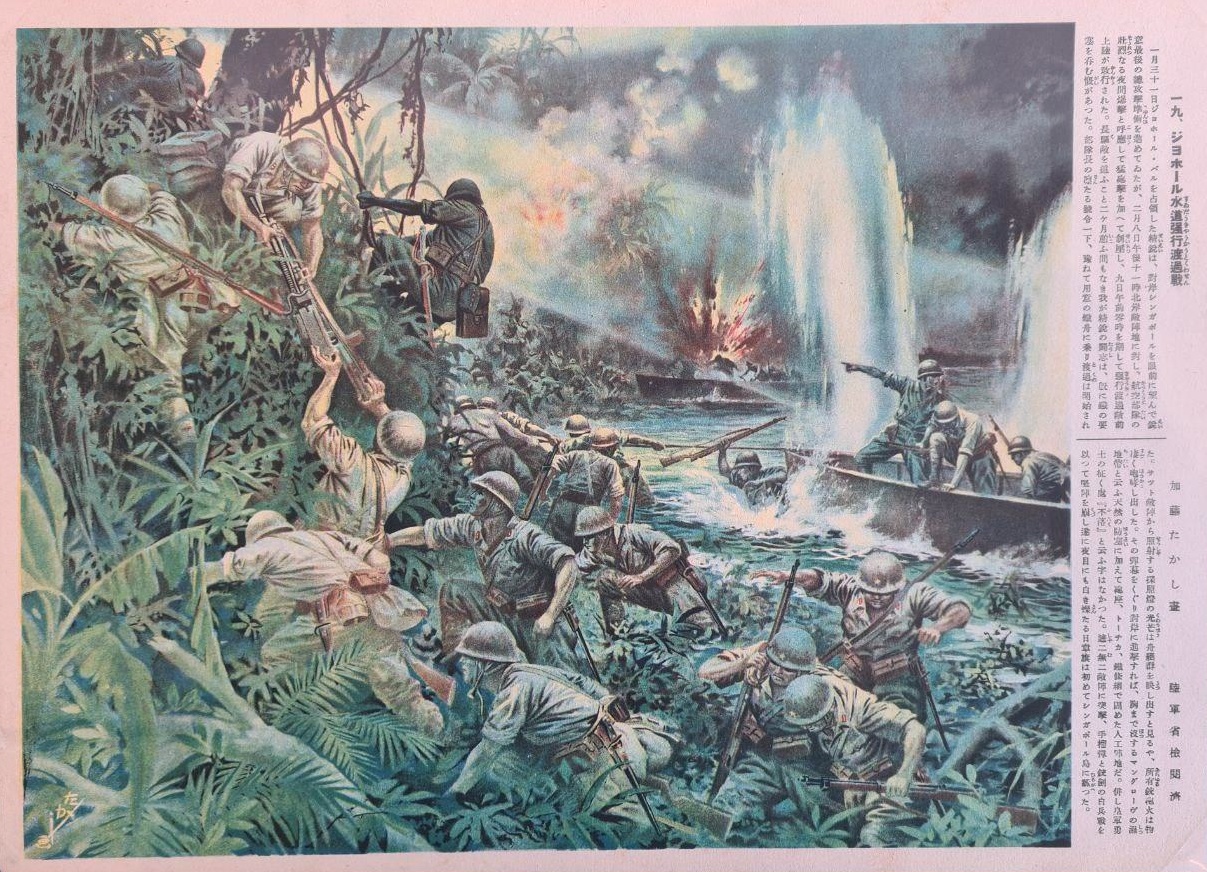 Japanese propaganda illustration depicting the Imperial Japanese Army's assault on Sarimbun Beach. Image taken at the "New Light On An Old Tale” exhibition at the National Archives of Singapore.
Japanese propaganda illustration depicting the Imperial Japanese Army's assault on Sarimbun Beach. Image taken at the "New Light On An Old Tale” exhibition at the National Archives of Singapore.
As the night clouds parted, the full moon illuminated a horde of Japanese assault boats approaching the beach. Within minutes, the tension in the air turned into a haze of ricocheting bullets, sand, and blood.
Chen Xi took a deep breath, tightened his grip on his rifle, and leapt into the fray.
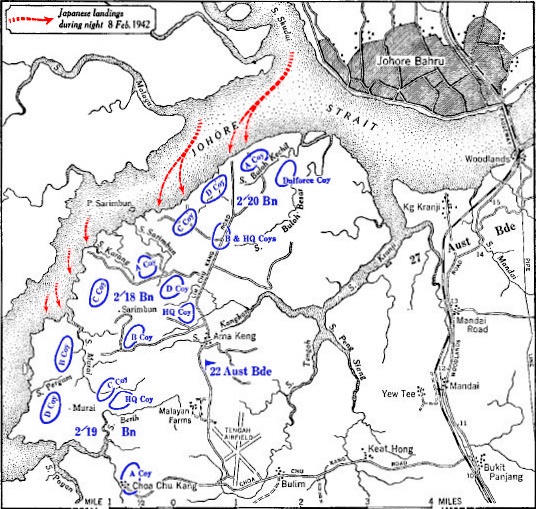 Map of Allied deployment (in blue) and Japanese landings (in red) on 8 February 1942. Via Wikipedia.
Map of Allied deployment (in blue) and Japanese landings (in red) on 8 February 1942. Via Wikipedia.
British Military Hospital (present-day Alexandra Hospital), Singapore
February 14, 1942, 1:30pm
Even though the nurse had assured him that he would be safe in a hospital, Ranjeet Singh was terrified.
He could hear shots being fired outside the hospital, and they were getting increasingly loud, mixed with the screams of staff and patients alike.
A loud bang echoed from the operating theatre next door.
Ranjeet broke out in cold sweat as he heard the slash of metal slicing into flesh and screams of agony. He slid himself off the bed and crawled frantically towards the nearest window as fast as his injured legs would allow him.
Just as his fingers grasped the ledge of the open window, the door to his ward burst open. The last things that Ranjeet saw were the bloodstained face of an Imperial Army soldier and the smoking barrel of his Arisaka Type 38 rifle.
Ford Motor Factory, Singapore
February 15, 1942, 6:20pm
Lieutenant-General Arthur Percival held his head low as he sat under the leering gaze of General Tomoyuki Yamashita at the Ford Motor Factory, which the Imperial Japanese Army had taken over as its headquarters.
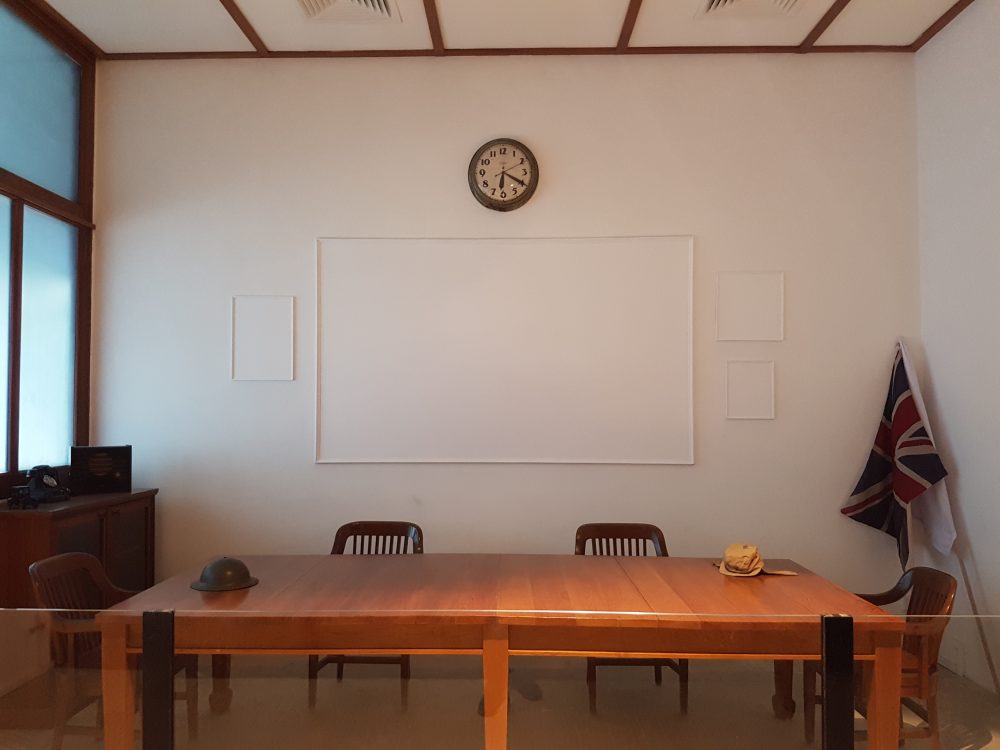 Surrender Room at the Ford Factory replicated at Surviving the Japanese Occupation: War and its Legacies.
Surrender Room at the Ford Factory replicated at Surviving the Japanese Occupation: War and its Legacies.
Percival knew that he had no choice but to surrender.
All of Singapore's reservoirs had fallen into Japanese hands, food rations were only expected to last three days, and the number of casualties from the battle had exceeded what the British were willing to suffer.
Percival would later concede that the defeat of the British in Malaya was due to "the lack of readiness of our Empire for war".
Within a week, Singapore would be renamed Syonan-to (Light of the South), with the Japanese flag hoisted on top of the Cathay Building.
Yamashita would go on to publish a declaration in the new state newspaper, the Syonan Shimbun (Syonan Times) on February 21, 1942, gloating over the humiliating defeat of the British and berating the "English egoism, injustice, and unrighteousness" as "beyond description, and worthy to be called as the common enemy of humanity".
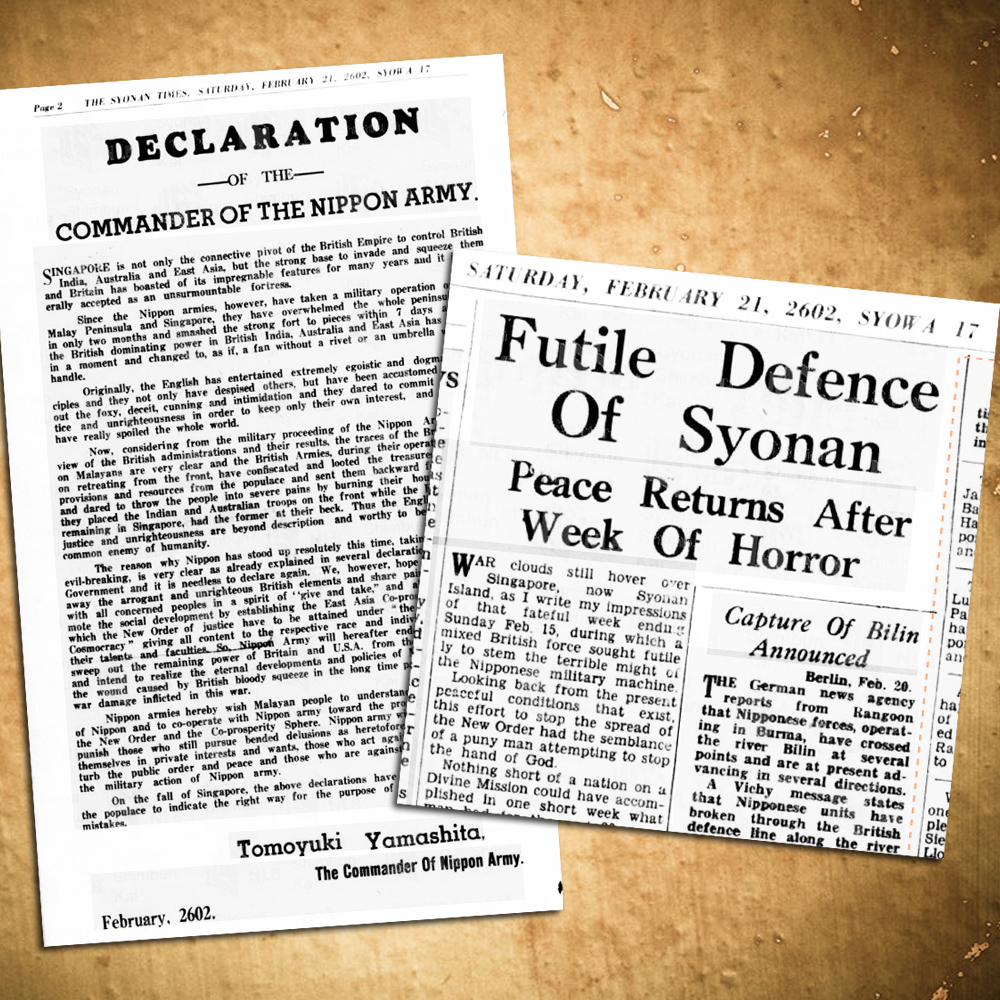 Newspaper articles from the Syonan Shimbun dated February 21, 1942. Taken from NewspaperSG.
Newspaper articles from the Syonan Shimbun dated February 21, 1942. Taken from NewspaperSG.
The declaration ended with an ominous warning, a foretaste of the horrors that laid ahead for Singapore:
"Nippon army will drastically expel and punish those who still pursue bended delusion... those who disturb the public order and peace and those who are against the orders and disturb the military action of the Nippon army.
On the fall of Singapore, the above declarations have hereby been given to the populace to indicate the right way for the purpose of eliminating their possible mistakes."
If you would like to find out more about the Fall of Singapore, the National Archives (NAS) is currently holding the "New Light On An Old Tale” exhibition which showcases artefacts from three private collections. The exhibition, which is held at Level 3 of the National Archives building (map), runs from February 15 to June 30.

Top image depicting the Imperial Japanese Army's assault on Sarimbun Beach, is available for viewing at the exhibition. This article was first published with the headline "On the road to Syonan-to: How Singapore got swept into WW2" in 2017.
If you like what you read, follow us on Facebook, Instagram, Twitter and Telegram to get the latest updates.

